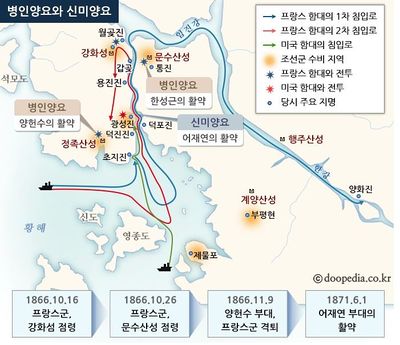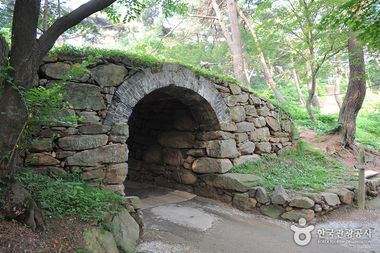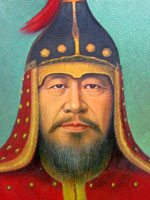GGHS 2019 Winter - Team 10
Write introduction about topic here.
목차
Team
| No. | Team Topic | Teacher | Role | Name (Korean) | No. of Students |
|---|---|---|---|---|---|
| 10 | Famous People and Historic Sites of Ganghwa (강화 유명인사 유적지) |
Margarita KICHUKOVA | Leader | 이하○ | 8 |
| Vice-Leader | 고바○ | ||||
| 김하○ | |||||
| 박진○ | |||||
| 한지○ | |||||
| 김도○ | |||||
| 박제○ | |||||
| 황예○ |
Topic
- Famous People and Historic Sites of Ganghwa
Introduction
[1] At the end of the Joseon Dynasty, there were two generals who defended Joseon from the invasions of the Western powers. Through this global camp, we explored the dramatic life story of those two generals. Namely, we focused on Jeongjoksanseong Fortress where General Yang Heon-soo pushed away the French soldiers during Byeongan Yangyo and on Gwangseongbo Fortress where General Eo Jae-yeon fought durting sinmi Yangyo. We think we that by learning about the origins and location of each battle site, we can feel the spirit of the people who led the Korean people through the development of those major historical events.
Body
Lee Gyu-bo
- the life story of Lee Gyu-bo
1168 He was born Ganghwa. 1189 He passed the gwageo at the top of his class. 1993 He wrote a Dongmyeongowangfyeon 1200 He was appointed to the high spot 1230 He was in the top position. 1241 Death
- Achievement
His poems, written by a Goryeo official and a prestigious artist tookthe world by storm during the Goryeo Dynasty. The books include Dongguk Sesanggukjip and Gukseon Saengjeon, and the works of King Dongmyeong. His nickname, "WhitecCloud liveman," is an expression of his free-spirited, cloud-like figure, a nickname that reflects his literary world, which sought novelty and individuality. In particular, the epic poem, "Jumong Chronicle," is considered a great achievement in Korean literature as an epic poem that sings the life and footprints of King Dongmyeong, the hero of the nation and founder of Goguryeo. In 1199 a rebellion broke out in Gyeongju and became a medical institution. In 1219, he was relegated to Gyeyang-gu, Incheon, as head of the current district office, for covering up the sins of the local government. the foot of Mt. Gyeyang here He left a jiao-panggi named after Zhao. During the War of Koryo and Mongolia, he also served as an official who prepared a foreign document to send to Mongolia. In his later years, he taught a student at the school in Ganghwa Island, the capital of refuge. Although he resigned from his office, he built a policy of torture by the government and a sign of going to and from foreign countries, and became seriously ill so that the supreme authority of the nation hurried his literary work, but ended his life without seeing any adultery. Achievements and evaluation of Lee Kyu-bo He was famous for writing impromptu poems that recited his impressions every time he was appointed to the high spot, He was called a big fan of three. because he liked poetry, geomungo, and art. He was so passionate about poetry that he can tell how important it was to him in his work, too fond of poetry. He also liked liquor so much that he couldn't write poetry without liquor, and he alcohol was given the title of teacher. He was also told, "Be careful of words" because of his bad temper. It wasn't a good chance of reaching a high position in the first half. But he climbed to a high position and had a relatively good life. On the other hand, he was a pure and conscientious official who did not intervene in the right.
Tomb of Lee Gyu-bo
| 이규보묘 | |
|---|---|
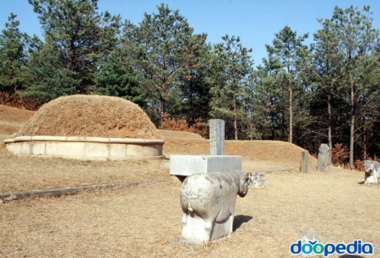
| |
| 지정 번호 | 인천기념물 제15호 |
| 지정일 | 1995년 03월 01일 |
| 지정 명칭 | 이규보묘 (李奎報墓) |
| 한자 명칭 | 李奎報墓 |
| 영문 명칭 | Tomb of Lee Gyu-bo |
| 분류 | Tomb |
| 건립·제작 | |
| 주소 | 인천광역시 강화군 까치골길 72-17 |
| 위도 | 37.668286 |
| 경도 | 126.484543 |
| 웹사이트 | |
It is located in the Gilsang-myeon, Ganghwa-gun, Incheon. On March 1, 1995, it was designated as Incheon Gwangyang Memorial Monument No.15. It was managed by Yeoju Yi Family and was restored in 1967 to a building built by descendants to clean up the tomb and perform ancestral rites. The tomb is 1.8 meters tall and has a circumference of 16 meters. At the bottom of it there is a stone pavilion to guard the tombs, and Jang Myung-light which illuminates the fore-stones and the tomb in front of the tomb, and the stone statue, A pair, stone lanterns and tombstones are arranged. The stone sheep is a piece of the Koryo period, which is very realistic
Yang Heon-soo
- the life story of Yang Heon-soo
1816 He was born in Yangpyeong. 1848 He was admitted tothe military service examination 1859 He was also assigned to Kapsan of Hamgyeong-do 1865 He was appointed as governor of Jeju. 1866 He was appointed to Dongbu Seungbu. He has become a captain of Jeongjoksanseong Fortress. 1866 French campaign against Korea happened 1875 he was appointed as a the Minister of Justice 1884 he was appointed to the minister of Works. 1888 Death
- Achievement (related to Ganghwa)
General Yang Heon-soo and Lee Yong-hee of Sunmujunggun’s Military Division led soldiers together with Lee Hyun-gyu of the Central Army to protect the Fort Sondolmok of Gwangseongjin. In 1866, French troops invaded Ganghwado Island. As a left-main commander, Yang headed about 500 soldiers and infiltrated the Jungjoksanseong. Yang Heon-soo chose to hide behind the walls of the fortress because his weapon performance was lower than that of the French army, considering the Joseon army's close firelock distance and the number of bullets they had left. Then he used the tactic of intensive fire when the French troops came to the castle. In other words, he fought a guerrilla war with the French Navy’s Colonel Olivier. On November 7, 160 French marines who were trying to attack the fortress led by Colonel Olivier, were driven to the brink of collapse by some 500 South Korean sailors. He was appointed asSeoul a deputy mayor. In addition, he was appointed Army Commander of Hwanghae in 1869. The crushing defeat in the Battle of Jungjoksanseong demoralized the French army, and in the end, French Admiral Rose decided to withdraw. According to the records of Joseon, six French soldiers were killed and 30 others wounded. On the other hand, French records show three dead and 35 wounded soldiers. In 2013, Seoul City designated Yang Heon-soo’s diary as a cultural property. Thanks to Yang Heon-soo, the documents and books kept in Jeongjok Mountain's archive inside Jungjoksanseong were protected from looting. In 1871, when he was serving as a soldier, Yang was in charge of conducting special tests for the selection of army officers every year as a way to encourage the new system to strengthen his defense. The participants were given preferential treatment as well as grain and cotton according to their grades. and he was appointed as a soldier for another year as such political achievements were recognized. The following year, he arrested and killed a group of pirates who were on the coast of Hwanghae.
Jungjoksanseong
introduce
One of the famous historical sites in Ganghwa is Jeongjoksanseong Fortress, located at 222m above sea level in the southern part of Ganghwa Island. It was first built during the Three Kingdoms Period and then reconstructed by king Yeongjo of Joseon. During the dynasties of Goryeo and Joseon, it was the most important government complex to protect the outskirts of the capital city as well as the city of Hanyang. Gangwhado is often referred to as “the throat of Seoul”, and the Jeongjoksanseong Fortress is in such a critical position that it could be called “the brain of Gangwhado”.consists of five mountain peaks, and the fortress was built where their ridges and valleys merge. As the fortress wall was built along the topography of the mountain, the height difference between its northern and its southern part appears to be large.
purpose
The fortress is believed to have been first built by the kingdom of Baekje during the Three Kingdoms Period. At that time, it was not only a gateway to the Han River, but also played the role of a defense mechanism as a fortress with only two roads – one to the East and one to the South being navigational.
Configuration
Surrounded by steep cliffs, the fortress facilities include four gates to four corresponding inside fortresses, namely Dongmun (East Gate), Nammun (South Gate), Seomun (West Gate), and Bukmun (North Gate).A distinguishing feature of the South Gate is its gate tower, Jonghae-roo, while the North Gate was built as a hidden gate.Inside Jeongjoksanseong Fortress, there are other buildings such as Jeondeungsa Temple, Jeongjoksan Temple, Gunchang and Gungigoo Military Warehouses The most recognizable amongst the gates is the East Gate, which has a brick-lined arch built over its pillars, similar to the West Gate which is also arch-shaped.Inside the fortress, there is a temple believed to have been built during the Goryeo Dynasty.
War of historical significance
In 1866 when the French army invaded Ganghwado Island, a fierce battle between Korea and France took place here. In response to the French army that occupied the then Ganghwa branch of Byeonginyang in 1860, thousands of Korean soldiers were dispatched to Joseon’s Ganghwa Island.Fortress on November 7 after crossing the Ganghwa coast with some 500 soldiers. Upon receiving news of the Korean army's entry into the fortress, French admiral Rose sent Colonel Olivier to take over the fortress.When French troops finally approached the castle, they fired close shots, causing the death of six and the retreat of 35 wounded French soldiers. French officers suggested attacking Jeongjok Mountain again, but Commander Rose ordered the army to withdraw from Ganghwa Island on the grounds that it was not strong enough to subdue the fortress.The battle resulted in many casualties and a setback in the war, forcing French troops to withdraw from Ganghwa. To commemorate Yang Heon-soo's victory at the South gate, a memorial stone was erected at the site.
Eo Jae Yeon
- the life story of Eo Jae Yeon
1823 He was born. 1841 He passed the military service examination and became an Gongchungdobyungmajerdosa (commander of army). 1866 Byeongin Yangyo broke up and defended at Gwangseongbo. 1871 During Byeongin Yangyo, he was recommended to Samgunboo (the government office in charge of military affairs) and dispatched to Sunmoo-young as a general. 1871 During Shin Mi Yangyo in Gwangseongbo, he was killed by a gunshot wound by James Doherty. After his death, he was promoted to Byeongjopanseo Jisamgunbusa. (Leader of Byeongjo, which was in charge of military affairs.)
- Achievement (related to Ganhwa)
Shin mi Yangyo (United States-Korea War of 1871)
Shin mi Yangyo (United States-Korea War of 1871) The war situation was not good when United States-Korea War of 1871 occurred as the U.S. forces had occupied the Chojijin and Deokjinjin fortresses and attacked Gwangseongbo, the main fortress. On June 11, 600 Korean soldiers, who were at the defence site in Gwangseongjin, struggled to fight the U.S. general offensive that took over Deokjinjin. As he was pushed from Gwangseongjin to the Son Dol Mok-dondae Fortress, General Eo Jae-yeon prepared for the final battle with 350 soldiers under his command. U.S. and Joseon troops engaged into a fierce battle of in Son Dol Mok-dondae Fortress . General Eo Jae-yeon led the battle against the U.S. on both water and land, fighting without backing down until the very end, before he was shot by the U.S. marine officer James Doherty. In the battle, the Joseon military suffered a crushing defeat, with 53 soldiers killed, 100 killed and 20 captured. However, the U.S. military, which praised the Joseon soldiers for their persistent battles, politely buried the bodies of the officers, including those of the officer's staff. While his was still alive, General Eo Jae Yeon, he erected a monument as a tribute to the loyalty of his two brothers - Eo Jae-soon and General Eo Jae-yeon.
Gwangseongbo
| Gwangseongbo | |
|---|---|
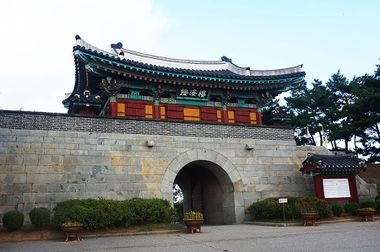
| |
| 지정 번호 | Historic Site No. 227 |
| 지정일 | |
| 지정 명칭 | 광성보 |
| 한자 명칭 | 廣城堡 |
| 영문 명칭 | Gwangseongbo |
| 분류 | |
| 건립·제작 | 1658(Hyojong 9) |
| 주소 | 833 Deokseong-ri, Bureun-myeon, Ganghwa-gun, Incheon |
| 위도 | 37.665267 |
| 경도 | 126.530094 |
| 웹사이트 | |
In 1618 in the 10th year of the Gwanghaegun of the Joseon Dynasty, it was renovated and installed Gwangseongbo in 1656. it’s Dondae was bulit in 1679. Dondae of Odu, Hwado, Gwangseong and Odujeong artillery unit was belonged to it. It was rebuilt as a complete stone fortress in 1745 and the gate was also installed. Gwangseongbo was the fiercest battle of the time. On April 24, 1871, when U.S. Rogers led a fleet of 1,230 troops to invade upon demand for commerce, after the landing force occupied Chojijin and Deokjinjin, they deploy hand-to-hand fight in Gwangseongbo. After this battle, Anhaeru, Gwangseongdon, Son Dolmok, Youngudon, and the tomb of General Eo Jae yeon who died in the war were all repaired and contructed on the site of the site purificatiion. Gwangseongbo is currently designated as Historic Site.
Conclusion
We investigated General Eojae's Sinmiyang and General Yang Heon-soo's ByeonginYo, and explored the place where the war took place. As a result, these two wars were representative wars that led to the victory of Joseon as a key point of Ganghwado Island, and played a major role in promoting Ganghwado to the world. It also contributed greatly to the peace of the Joseon Dynasty. By defeating the U.S. and French forces that invaded the country first, it laid the foundation for peace in the country and in relations with the country in the world. we felt that the history of Ganghwado has been revived through today's challenge of exploring people with interest in our own faults, or the strength of our friends' faults. Also, General Yang Hun-soo, who was visibly inferior, led the team to victory through perseverance, passion and cooperation, has become the driving force and strength base for us in the global camp. we think we should give a tribute to the two generals who contributed to the peace of the Joseon Dynasty.
Map(s)
Network Graph(s)
- SAMPLE: VH2018_부석사reference.lst
- YOUR TEAM GRAPH: GGHS2019W_Team10.lst


